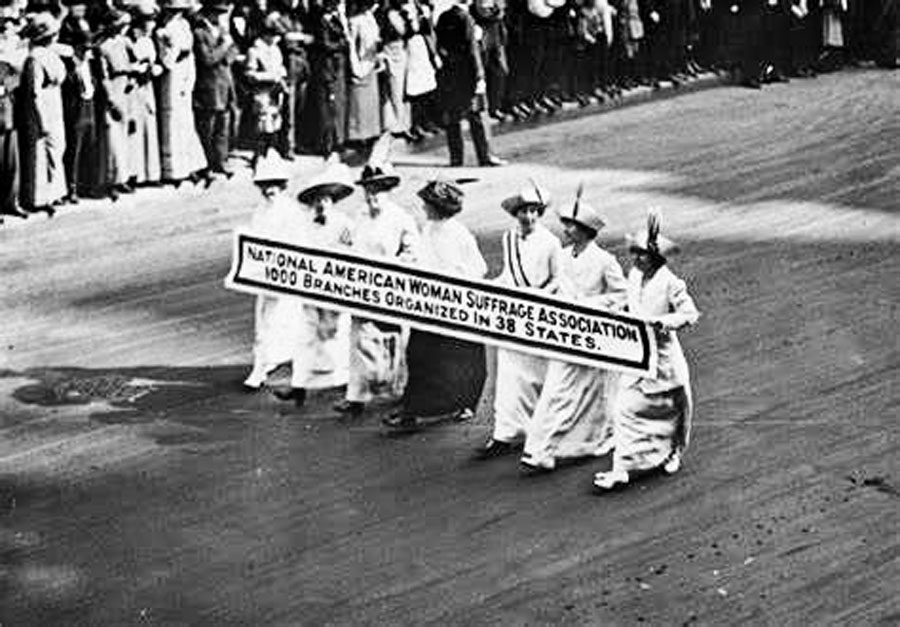March … to equality: A historical recap of women’s history

In 1913, 5,000 women marched in the Woman Suffragette Parade in Washington, D.C.
It was not long ago that women couldn’t vote, open a bank account on their own or be considered in the running for a promotion. Thanks to a designation by Congress in 1987, the month of March is recognized as Women’s History Month and is a good time to recap and reflect on the always challenging and sometimes rewarding journey of the fairer sex through the years.
In 1776, Abigail Adams, wife to founding father and future president John Adams, pleaded with him and the Continental Congress to “remember the ladies … do not put such unlimited power into the hands of the husbands.”
The first tangible step for the feminine movement took place in upstate New York in the summer of 1848. Elizabeth Cady Stanton, a young wife and mother, met with like-minded peers to include Susan B. Anthony and expressed dismay at the status of women in the wake of the newish democracy and Revolutionary War where freedom from tyranny was considered a God-given right. Within days of their meeting, the ladies boldly planned “The First Convention” to discuss women’s rights in Seneca Falls. Using the Declaration of Independence as a guide, Stanton wrote the “Declaration of Sentiments.”
“The history of mankind is a history of repeated injuries and usurpations on the part of man toward woman, having in direct object the establishment of an absolute tyranny over her,” she wrote demanding women receive “all the rights and privileges which belong to them as citizens of these United States.” It took 72 years for women to get the vote.
In 1913, 5,000 women marched in the Woman Suffragette Parade in Washington, D.C., which took place the day before the inauguration of President Woodrow Wilson and sparked new life in the women’s movement. Three years later, Jeannette Rankin was the first woman elected to Congress and was instrumental in getting the ratification of the 19th Amendment in 1920; finally, women (white women that is) could vote.
With the outbreak of World War II, women, who were largely homemakers, stepped in to replace the millions of civilian and military jobs that had become available. Rosie the Riveter, who was inspired by a real worker, was a government campaign to encourage women to help out a country in need. Many historians tout Rosie as one of the earliest international symbols of women’s liberation. After the War, some women understandably wanted to keep working, but most were demoted when men returned to their places of employment.
The “first lady of civil rights” became a household name in 1955 when she, Rosa Parks, refused a bus driver’s demand to move to the back of the bus. She was arrested, but this act eventually led to a federal court decision that bus segregation was unconstitutional under the 14th Amendment.
The 1960s and ‘70s became known as the “second wave of feminism.” Betty Friedan penned The Feminine Mystique which openly addressed women’s challenges of hopelessness and despair with traditional female roles as being a wife and mother and basically relying on men for everything in their lives. This book, among the pervading sexual revolution of the time, gave way to women’s liberation movements all over the country. Gloria Steinem became the spokesperson for the cause. Also, the invention of the birth control pill gave women control over their bodies, family planning being a key benefit.
Politics for women was also evolving. In 1964, Patsy Mink was the first Asian American elected to Congress, and in 1968, Shirley Chisolm was elected as the first Black woman. By 1979, the number of women serving as federal judges more than doubled. In 1984, Geraldine Ferraro became the first woman to run as a vice presidential nominee.
The 1990s welcomed the lesser known “third wave of feminism.” Generation Xers focused more on social, gender and economic justice as well as pushing women to be empowered and high achievers.
In America’s 247 years, there are too many firsts to list all of the trail blazers, but here are some honorable mentions: Amelia Earhart (first female pilot to fly across the Atlantic), Eleanor Roosevelt (first first lady to redefine the role and lead a public life), Katherine Graham (one of first woman publishers of an American newspaper and first female CEO of a Fortune 500 company), Sandra Day O’Connor (first female supreme court justice), Madeleine Albright (first female secretary of state), Sally Ride (first female astronaut to go into space), Hillary Clinton (first presidential candidate of a major political party), Nancy Pelosi (first female speaker of the House), and Kamala Harris (first female vice president).
Remember these women and all the many more who stood up, leaned in, pushed their way to the front, earned their way to the C-suite. And it would seem the saying is true: “Well-behaved women rarely make history.”
By Hollen Wheeler; courtesy photo